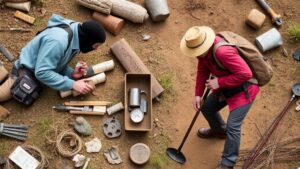Exploring Railroad Worker Camps for Hidden Treasures
Exploring Railroad Worker Camps for Hidden Treasures
The history of the American railroad system is not merely a tale of tracks and trains; it encompasses the lives, struggles, and aspirations of countless workers who helped shape the nation. Among the remnants of this history are railroad worker camps, often overlooked but rich in potential hidden treasures. These camps were essential to the development of the rail industry, serving as temporary homes for laborers who faced challenging working conditions. This article delves into the significance of these camps and explores their potential for uncovering historical artifacts and treasures that tell the story of Americas railroad past.
The Historical Context of Railroad Worker Camps
During the 19th and early 20th centuries, the expansion of railroads across the United States created a formidable demand for labor. Workers, often immigrants or marginalized communities, were enlisted to lay tracks, construct tunnels, and build bridges. To support this workforce, temporary camps were established, typically located near construction sites. e camps were basic, consisting of tents or wooden barracks, and operated with limited amenities. But, their significance cannot be understated, as they became hubs of socialization and community among workers.
Types of Treasures Found in Railroad Worker Camps
When exploring former railroad worker camps, treasure seekers should focus on the types of artifacts that can provide insights into the lives of those who lived there. The following are some categories of hidden treasures that may be recovered:
- Personal Belongings: Items such as tools, clothing, and personal effects reveal the daily lives of workers. For example, rusted tools used for laying tracks or sewing needles can provide insights into the trades performed and the domestic lives of the workers.
- Building Materials: Remnants of construction materials, such as bricks from old camp structures, can tell stories about the living conditions and architectural choices of the time.
- Food Utensils: Discoveries of dining ware, cooking utensils, or remnants of food preparation can indicate the dietary habits and communal practices of the workers.
Case Studies of Discoveries
Several notable instances illustrate the potential for discovery in railroad worker camps:
- The California Transcontinental Railroad: Archaeological digs along the historic routes have uncovered artifacts from worker camps, including tools and fragments of personal items that date back to the mid-1800s. One notable site revealed a cache of items that helped historians reconstruct the socio-economic conditions of the time.
- The Union Pacific Railroad Camp: A site in Wyoming yielded a trove of dining utensils and personal artifacts. Archaeologists were able to glean valuable information about the cultural practices of the diverse workforce, including aspects of their cuisine and daily routines.
Challenges in Treasure Hunting
While searching for treasures in railroad worker camps can be thrilling, it often comes with significant challenges. Understanding these obstacles is crucial for responsible and effective exploration. Some of the primary concerns include:
- Legal Restrictions: Many sites are protected by laws that prohibit digging or alteration. Familiarity with local regulations is essential to avoid legal repercussions and ethical dilemmas.
- Preservation of Artifacts: Disturbing archaeological sites without proper techniques can lead to damage and loss of context. Preservation of artifacts in their original setting provides invaluable historical information.
Real-World Applications of Discoveries
Discoveries made at railroad worker camps have far-reaching implications not only for historical scholarship but also for public education and heritage tourism. Artifacts unearthed can lead to:
- Exhibitions: Museums may use items from these sites to enhance their collections, providing visitors with tangible connections to the past.
- Educational Programs: Schools and universities can benefit from historical findings for teaching purposes, incorporating real-world context into lessons about industrialization and immigration.
- Cultural Preservation Initiatives: Findings can invigorate local histories, prompting communities to preserve their railroad heritage through public events and storytelling.
Actionable Takeaways
Whether you are a historian, archaeologist, or mere enthusiast of American history, the exploration of railroad worker camps holds significant potential for unearthing hidden treasures. To embark on this journey:
- Conduct thorough research: Use local libraries or historical societies for information on nearby railroad camps.
- Get involved: Join local archaeology or history groups focused on preserving railroad history to share knowledge and resources.
- Respect the sites: Always seek permission before exploring, and adhere to legal guidelines to ensure the preservation of historical integrity.
To wrap up, railroad worker camps, with their unique combination of rich history and potential discoveries, present an exceptional opportunity to dive deeper into understanding America’s past. By exploring these sites, we honor the laborers contributions and continue to uncover narratives that shape our collective identity.

